The nail fungus on the legs is a common pathology, which is accompanied by unpleasant symptoms: cringing or stratification of the nail plate, a change in its shade, pain, itching and other negative sensations.What are the causes of the disease, what types and stages are it?How to diagnose and eliminate damage to the nail plate?Is it possible to warn the pathological process?
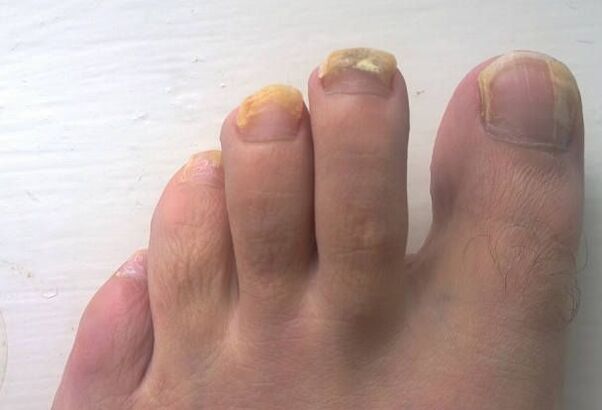
What is onychomycosis, for what reasons it arises
The fungus of nails on the legs, or onychomycosis is a disease caused by dermatophytes, mold, yeast and other varieties of mushrooms.This is a secondary infection that occurs after lesions of the skin of the feet.
The main factors affecting the development of pathology:
- age and gender of man;
- climatic conditions;
- concomitant diseases;
- profession.
The disease can occur for the following reasons:
- dampness contributes to the rapid spread of the fungus, especially if a person neglects shoe drying;
- Visiting a bath, pool, a common soul without personal shoes, walking with bare feet;
- non -compliance with the elementary rules of hygiene;
- getting into a favorable environment of dried particles of fungus, which are on the skin;
- pathologies of the endocrine system, metabolic disorders;
- foot deformation and circulatory violation in it;
- Wearing inconvenient and inappropriate in size of shoes.
Varieties of the fungus and their features
There are 3 main types of onychomycosis:
- Normotorophical.This type is characterized by a change in the shade of nails, the appearance of stripes and stains from white to yellowish color.The shine and strength of the nail plate are preserved.
- Hypertrophic.The shade of nails is changing - they become dull, thicker and partially destroy.Very often, patients with such a disease are painful to walk.
- Onycholithic.The nail plate is intensively stained in gray and gradually rejected by the surrounding tissues.
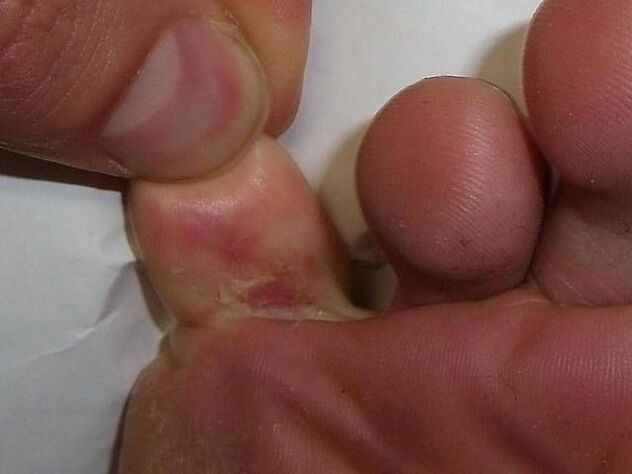
Varieties of onychomycosis at the place of lesion:
- distal (the nail is affected at the free edge);
- lateral - damage to the sites on the sides;
- proximal - the rear roller is affected;
- Total - the entire nail plate suffers from the disease.
The stages of onychomycosis, accompanying symptoms
The fungus of nails on the legs does not defeat the phalanx immediately and completely, the disease gradually goes through several stages:
- early (initial);
- launched (late).
At the very beginning of a fungal disease, after a violation of the integrity of the skin of the feet, itchy sensations between the fingers occur, cracks and bubbles appear.Gradually, the infection affects different parts of the nail.In most situations, at an early stage, pathology cannot be diagnosed independently due to the lack of pronounced symptoms.Small stripes and other interspersed on the nail plate are practically not visible to the naked eye.Laboratory diagnostics are shown.
The advanced stage is an extensive damage to the nail and the entire phalanx part.In the absence of timely treatment, there is a complete loss of the nail plate, impaired skin integrity and the transition of harmful microorganisms that caused the infectious process to the hands.
The main symptoms of the late stage of pathology: detachment and cringing of the nail plate, violation of its shape and thickness.The last stage of the disease is the complete destruction of the nail or its pronounced deformation, as well as the development of complications under the influence of a fungus that require long and complex therapy.

Diagnostic methods
In order to diagnose onychomycosis, you should contact a dermatologist.The doctor will prescribe laboratory studies (mycological, microbiological and histological), evaluate the results of the tests, symptoms and conduct a survey and personal examination of the patient.
Therapeutic tactics depend on the severity of the disease, its causes, concomitant symptoms and the type of pathogen.The diagnosis is confirmed or refuted when using Wood luminescent lamp.Differential diagnosis is carried out for distinguishing between the fungus from other diseases (psoriasis, eczema, red flat lichen, etc.).
Features of treatment
Any fluctuations in the appearance of the nails (persistent and slowly progressive) in shape, color, thickness, structural features are the reason for immediate contacting the dermatologist.The sooner the patient begins local treatment, the lower the likelihood that the use of funds for oral use, which act comprehensively on all systems of the body, will be needed.
Folk remedies have proven their effectiveness in the early stages of onychomycosis, and their use is welcomed by doctors.However, all procedures, drug treatment, folk therapy should be agreed with the attending physician according to the results of laboratory and hardware research, studying the anamnesis and evaluating concomitant symptoms.

External use
If the disease has just begun to actively develop and has not reached the late stages with severe symptoms, we can limit yourself to applying local antifungal pharmacy drugs.It is enough to apply a cream, gel or solution per pathological area a couple of times a day, morning and evening.
Before local application of drugs, it is necessary to first prepare the nail plates.First of all, it is necessary to immerse the feet in a soap-liner solution (in a half-filled pelvis with hot water, 1 tbsp and 50 g of laundry soap should be dissolved).Thanks to such a 15-minute bath, layers on the nails are significantly softened, which should be removed with manicure scissors or nippers and fired with a file.
When processing, you should not use the same manicure devices for simultaneous care for patients and healthy nails.
In the earliest stages of fungal damage, you can use special antifungal varnishes.The duration of therapy is about a year.
Oral preparations
If the disease has passed the initial stage and develops every day, the oral use of drugs in a tablet form is indicated.Such drugs help to overcome the disease even in the most advanced stages.Penetrating into the blood, the active components of drugs are comprehensively affect all body systems, which does not allow the fungus to penetrate healthy organs.
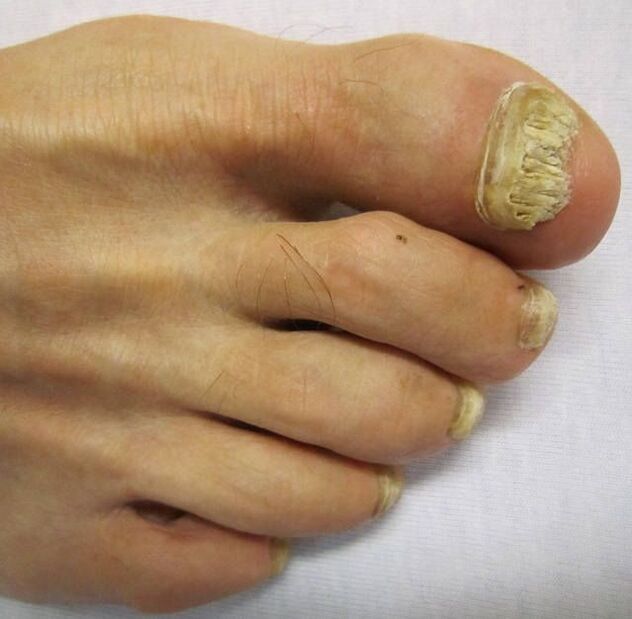
Physoalization
An effective method of physiotherapeutic treatment is a laser therapy.However, to achieve a persistent effect of laser therapy, this procedure is shown in combination with taking medications - the laser is not able to independently kill the fungus without pharmacy.Laser therapy helps to prevent relapse of the disease due to the penetration of rays into the deepest layers of the skin, reaching distant foci of the lesion.
With advanced forms of onychomycosis, electrochemical methods of physiotherapeutic effects are effective.These are procedures such as electrophoresis and ionophoresis.Physiotherapy helps to penetrate drugs to the affected areas of the skin and the destruction of yeast -like and other varieties of fungus.
Surgical removal of the nail plate
Many experts recommend surgical removal of the nail plate damaged by a fungus if the disease is in an advanced stage, while other methods have shown their inefficiency.The operation is carried out on an outpatient basis or hospital with preliminary anesthesia.
Possible complications after surgical intervention:
- pain;
- penetration of infection into the wound;
- Further growth of nails of irregular shape.
Carrying out surgical intervention is contraindicated in persons:
- with slowly healing wounds;
- having lameness;
- With poor filling capillaries with blood confirmed by diagnostic studies.
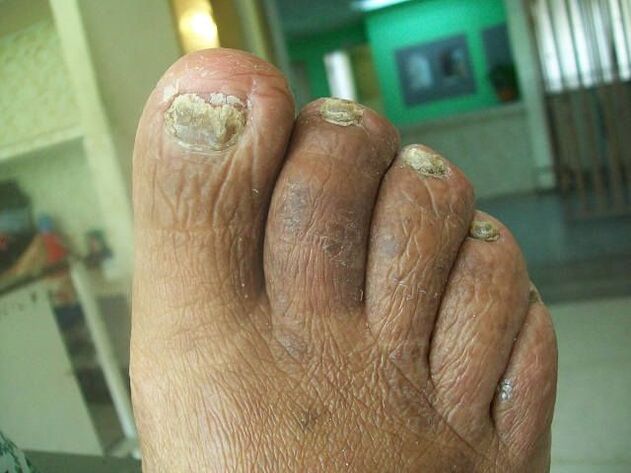
Recommendations after the operation:
- Do not load your fingers for several days;
- Do not wet the bandage for a week;
- avoid tight shoes;
- regularly treat the wound with an antiseptic, make dressings;
- Periodically visit a dermatologist to assess the quality of treatment and prevent relapse of the disease. People's means
Even specialists welcome treatment with folk remedies.The main condition is a preliminary consultation with the attending physician for calculating dosages and receiving recommendations.
Effective folk remedies for nail fungus:
- Vinegar.Harmful microorganisms that cause a pathological process die in an acidic environment.It is enough to make vinegar baths daily (water at room temperature with vinegar in a proportion of 8: 1) for 15 minutes.Before the procedure, you should steam your legs.
- Propolis.The tool is effective only with systematic use.You should take a 25%tincture of bee glue, moisten a cotton pad in it, attach to the pathological site and fix the gauze bandage at night.
- Iodine.This is the simplest and most effective method of treating the fungus of the nail plates.On well -washed and dried nails, iodine should be applied with a cotton swab, affecting only the damaged area of the nail.Therapy should last about a month.
- Soda.In 2 liters of warm water, 1 tbsp should be dissolved.l.soda.In such a bath, you need to keep your legs for about 15 minutes.
- Essential oils.The greatest efficiency was shown by tea tree oil.The substance should be rubbed into the damaged nail plate 2 times a day for at least 3 weeks.
- Herbs -based products.The most effective are the following herbs: celandine, thyme, burdock, golden mustache.
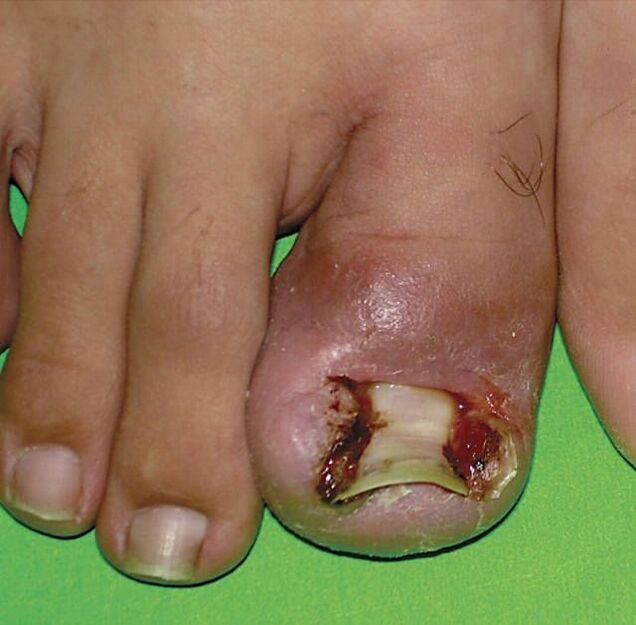
Errors in treatment and their consequences
3 common errors made by many patients during the treatment of onychomycosis:
- improperly prescribed drugs;
- outdated approach to treatment;
- Failure to fulfill preventive measures to prevent infection.
The fungus of nails on the legs with insufficient treatment or its absence can cause eczema, lymphostasis, the attachment of a bacterial infection with the development of inflammation, the complete loss of the nail plate, the inflammatory process in the lower extremities and other pathologies.If the fungal infection spreads throughout the nail plate, it is urgent to begin treatment in order to avoid the appearance of complications.If the patient has strong immunity and there is no pronounced symptoms of onychomycosis, the body is able to cope with the infection without outside help.
Preventive measures
In order to prevent the appearance of onychomycosis, it is necessary to adhere to the following rules:
- Wash your legs daily with warm water with soap or other skin washing;
- use a pumice or a special brush to remove keratinized and dead skin layers;
- wipe your legs well after washing, paying special attention to the intervals between the fingers;
- start a separate towel for the legs, regularly wash it at high temperatures;
- use talc and other cosmetics for intensive sweating of the legs;
- Do not neglect the rules of personal hygiene, especially after physical exertion and in the hot season;
- choose comfortable shoes made of natural materials, in size, which does not rub and compress the phalanges of the toes;
- after wearing, giving shoes to dry from moisture;
- Do not put on socks and shoes on wet legs;
- In the rain or snow, always change shoes, falling into a warm dry room.
The fight against the fungus of the nail should begin, armed with knowledge about it.Thanks to this selection, you can independently decide on the pathogen, localization and severity of onychomycosis and start taking some actions in time.
















